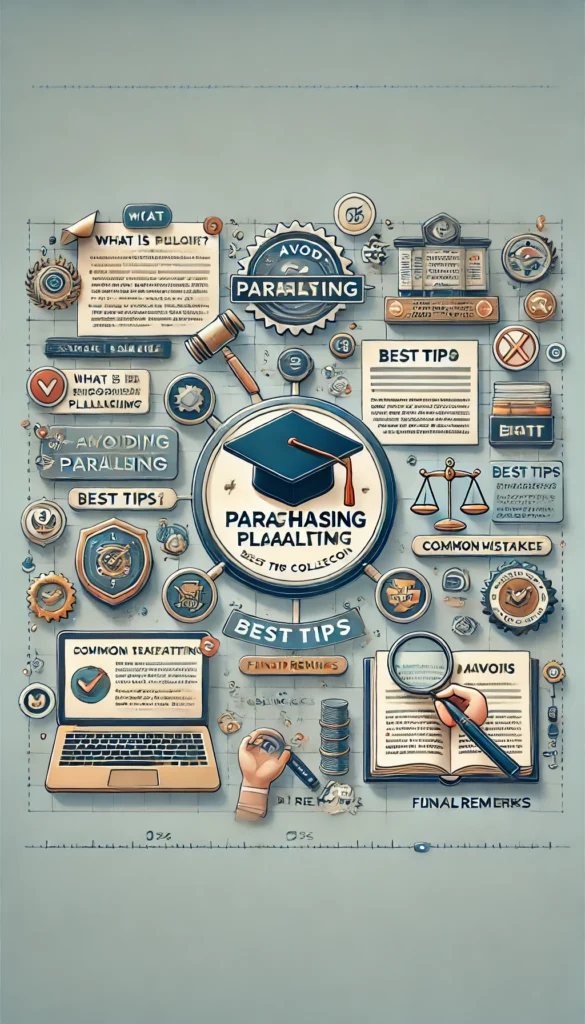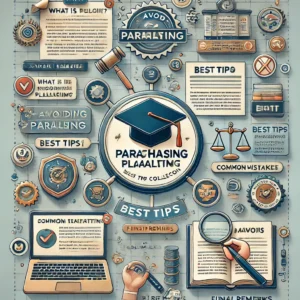Table of Contents
Paraphrasing Plagiarism: Best Tips Collection
Paraphrasing is an essential skill for writers, researchers, and students to convey information in their own words. However, paraphrasing can sometimes lead to plagiarism if not done correctly. In this blog, we’ll explore the concept of paraphrasing plagiarism, provide valuable tips to avoid it, and ensure your writing remains original and credible.

What is Paraphrasing Plagiarism?
Paraphrasing plagiarism occurs when someone rewrites another person’s work without proper acknowledgment, making it seem like their own. It involves changing words and sentence structures but keeping the original meaning and ideas intact without giving credit to the source. This form of plagiarism is just as serious as direct copying and can lead to severe consequences in academic and professional settings.
Paraphrasing plagiarism can be unintentional, often resulting from a lack of understanding about how to properly cite sources or from attempting to rush through writing assignments. Regardless of the intent, it’s crucial to recognize that using someone else’s ideas without appropriate credit undermines the integrity of your work and can have lasting impacts on your academic and professional reputation.
Why is Avoiding Paraphrasing Plagiarism Important?
Academic Integrity: Maintaining honesty in your academic work is crucial. Proper paraphrasing ensures that you respect the intellectual property of others. Academic institutions have strict policies against plagiarism, and violating these can result in penalties such as failing grades, suspension, or even expulsion.
Credibility: Original work enhances your credibility as a writer or researcher. Proper citation and paraphrasing show your ability to understand and interpret information. Demonstrating your ability to accurately paraphrase sources indicates to your readers or peers that you have a deep understanding of the material and can engage with it critically.
Legal and Ethical Standards: Plagiarism can lead to legal repercussions and damage your reputation. Adhering to ethical standards is essential in any writing endeavor. In professional environments, being accused of plagiarism can damage your career prospects and professional relationships. Legal consequences can include lawsuits for copyright infringement if the paraphrased material is used without proper attribution.
Best Tips to Avoid Paraphrasing Plagiarism
| Tip | Description |
|---|---|
| 1. Understand the Original Text | Before attempting to paraphrase, ensure you fully understand the original text. Comprehend the main ideas and concepts to accurately convey them in your own words. Spend time reading the source material thoroughly, taking notes, and highlighting key points. This will help you internalize the information, making it easier to restate it in a new form. |
| 2. Use Your Own Words and Style | When paraphrasing, use your own vocabulary and sentence structure. Avoid merely swapping out words with synonyms. Aim to express the original idea in a new and unique way. Your paraphrasing should reflect your voice and writing style, making the text sound like something you would naturally write. This personal touch helps distinguish your work from the original source. |
| 3. Change the Structure | Alter the sentence structure and the order of ideas presented. This not only helps in avoiding plagiarism but also demonstrates your understanding of the material. By reorganizing the content, you can provide a fresh perspective on the topic. Consider breaking down complex sentences into simpler ones or combining shorter sentences to enhance clarity and readability. |
| 4. Use Multiple Sources | When gathering information, refer to multiple sources. This helps in creating a more comprehensive understanding and reduces the risk of closely mirroring a single source. Synthesizing information from various references allows you to integrate different viewpoints and insights, enriching your writing. It also minimizes the likelihood of inadvertently copying the structure or wording of any single source. |
| 5. Cite the Source | Always provide proper citations for the ideas and information you paraphrase. Even if you have rewritten the content, acknowledging the original source is crucial. Different citation styles (e.g., APA, MLA, Chicago) have specific guidelines for paraphrasing, so be sure to follow the appropriate format. Accurate citation not only gives credit where it’s due but also allows readers to verify the information and explore the original sources. |
| 6. Use Plagiarism Checkers | Utilize plagiarism detection tools to ensure your paraphrased content is free from unintentional plagiarism. These tools can identify similarities and help you make necessary adjustments. Online tools like Turnitin, Grammarly, and Copyscape can compare your text against a vast database of sources, highlighting any overlapping content. Reviewing these reports allows you to revise problematic areas and ensure your writing is genuinely original. |
| 7. Practice Regularly | Paraphrasing is a skill that improves with practice. Regularly paraphrase different texts to enhance your ability to convey ideas uniquely and accurately. Engaging in exercises like summarizing articles, rewriting passages, and creating abstracts can help you develop a knack for effective paraphrasing. The more you practice, the more confident you’ll become in producing high-quality, original content. |
Examples of Proper Paraphrasing
Original Text: “Climate change is a significant global challenge, impacting ecosystems and human societies.”
Improper Paraphrasing: “Climate change is a major worldwide problem, affecting ecosystems and human communities.”
Proper Paraphrasing: “One of the most pressing global issues today is climate change, which influences both natural environments and human populations.”
In the proper paraphrasing example, the sentence structure has been altered, and different words are used to convey the same idea, demonstrating a clear understanding of the original content without copying its form. Check our paraphrasing tool
Save your time! We can take care of your essay
Proper editing and formatting
Free revision, title page, and bibliography
Flexible prices and money-back guarantee
PLACE ORDERCommon Mistakes to Avoid
Minimal Changes: Simply changing a few words here and there is not enough. Thoroughly rephrase the content to ensure it’s genuinely original.
Omitting Citations: Never forget to cite the source, even if you have paraphrased extensively. Proper citation is essential to avoid plagiarism accusations.
Overuse of Quotes: While quoting can be useful, overreliance on direct quotes can lead to plagiarism. Balance quotes with your own interpretations to show your engagement with the material.
Final Remarks
Paraphrasing is a valuable skill that, when done correctly, allows you to engage with existing literature while maintaining your originality. By understanding the original text, using your own words, changing sentence structures, citing sources, and practicing regularly, you can avoid paraphrasing plagiarism. Always strive for academic integrity and credibility in your writing.
FAQs on Paraphrasing Plagiarism
What is paraphrase plagiarism?
Answer: Paraphrase plagiarism occurs when someone rewrites another person’s work without proper acknowledgment, making it seem like their own. It involves changing words and sentence structures but keeping the original meaning and ideas intact without giving credit to the source. This form of plagiarism is just as serious as direct copying and can lead to severe consequences in academic and professional settings.
How do you paraphrase without plagiarizing?
Answer: To paraphrase without plagiarizing, follow these steps:
- Understand the Original Text: Fully comprehend the main ideas and concepts.
- Use Your Own Words and Style: Rewrite the information using your own vocabulary and sentence structure.
- Change the Structure: Alter the order of ideas and the sentence structure to provide a fresh perspective.
- Cite the Source: Always give proper credit to the original source, even if you have paraphrased extensively.
- Use Multiple Sources: Integrate information from various sources to reduce the risk of closely mirroring any single source.
What is acceptable paraphrasing?
Answer: Acceptable paraphrasing involves:
- Thorough Rewriting: Completely rephrasing the original text using your own words and sentence structures.
- Clear Understanding: Demonstrating a clear understanding of the original content by accurately conveying its meaning.
- Proper Citation: Providing appropriate citations to acknowledge the original source.
- Unique Expression: Ensuring that the paraphrased content reflects your unique voice and style.
Is it still plagiarism if you change a few words?
Answer: Yes, it is still considered plagiarism if you only change a few words. This is known as “patchwriting” and does not count as proper paraphrasing. True paraphrasing involves a complete rephrasing of the original text while maintaining the original meaning, along with proper citation of the source. Simply swapping out a few words with synonyms does not make the work your own and can still be flagged as plagiarism.


